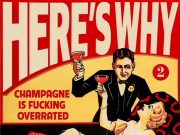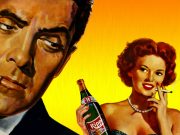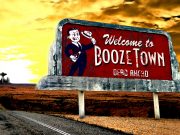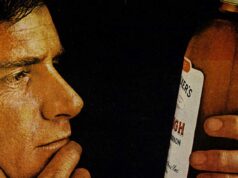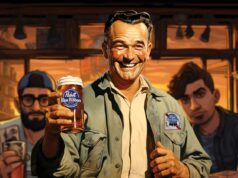William Wilson was, by his own account and those of others, a degenerate alcoholic.
After a quasi-religious epiphany, he “cured” himself and went on to found, along with Robert “Dr. Bob” Smith, Alcoholics Anonymous. Their goal was a national and international organization based on the concept of one alcoholic helping another to stay sober. That they more or less succeeded is uniformly recognized as fact. In 1990, Life magazine called Wilson one of the most influential men of the 20th Century.
Today, AA boasts millions of adherents and chapters in nearly every country in the world. It has spawned many partner groups, including ALATEEN and All Addicts Anonymous (AAA). Its master organization, the AL-ANON Family Groups, Inc., publishes a catalogue of self-help books, most notably Twelve Steps, Twelve Traditions and Alcoholics Anonymous (a.k.a. The Big Book), a monthly magazine called The Grapevine, and numerous film and video packages of interest to members.
AA’s global influence is massive, but its philosophy, history, and its prime mover, Bill Wilson, were and remain controversial.
* * *
Bill “Bill W.” Wilson was born November 26th, 1895 in Vermont, the scion of a long line of granite quarry workers and mine bosses. He was educated at the prestigious Burton and Burr academy before joining the Army at the onset of US involvement in W.W. I. It was in the military (where Wilson had a desk job and never saw combat) that he took his very first drink and discovered that he didn’t just like it, he loved it. He quickly graduated to a full-bore drunkard, and a violent one at that.
Which wasn’t too much of a problem at first. Wilson possessed a fine mind, he was logical and scientific, one of those guys who can fix a broken machine by taking it apart and studying how it works.
When he got out of the military, he turned his natural genius toward the world of high finance, where it meshed nicely with his almost pathological need to make money and to be esteemed as a Great Man.
It wasn’t long before the ambitious and talented Wilson was a force to be reckoned with on the Wall Street of the rollicking 1920s. He would learn all he could about the inner workings of a publicly-traded company then make recommendations to buyers based on his unique understanding. Today Wilson would be considered a common, albeit gifted, stock analyst, but back then he was one of the few people doing that sort of thing. Savvy investors soon flocked to Wilson and it didn’t take long before he realized he could use his influence and advice to artificially inflate the price of a company’s stock, including those in which he had a financial stake. These days that sort of behavior is a crime called insider trading, but in the ‘20s it was called playing the game and no one cared that much. Wilson certainly didn’t. He raked in the cash with both hands.
He spent that money, too. The best of everything was never quite good enough for Bill. He had to have more, he had to have better. While he justified his lavish lifestyle to acquaintances by explaining that he had grown up poor, this was hardly the case. Only he and his wife, Lois, knew otherwise, and he perpetuated the myth for decades.
Apart from occasionally drinking himself catatonic, Wilson’s life rolled along swimmingly, right up until October 24th, 1929. On the day that will be forever be known as Black Thursday, the stock market crashed (due in large part to just the sort of insider shenanigans that had made Wilson fabulously wealthy) and he lost everything. Overnight, he went, like so many other Americans, from white spats and hot jazz to starved for button thread or a decent meal.
The only part of his life that remained the same was his obsession with getting loaded. Wilson used his keen intellect to discover inventive new ways to get a hold of drinking money, such as not paying the rent.
Then, on December 11th, 1934, after five years on the bum, something happened. No one, and especially not Wilson himself, was ever able to adequately articulate what occurred, but according to the standard tale it went something like this:
After repeatedly failing to get his drinking under control, Wilson, trembling on the brink of insanity, called up into the sky, “If there be a God, let Him show Himself now!” Suddenly, a warm bright light filled the room and Wilson found himself standing atop a mighty mountain. A wind came to him, surrounding his body and moving through it. With its departure, Wilson fell back into himself and never touched another drop of alcohol.
A life-long agnostic who sometimes espoused atheism, Wilson took pains to avoid terming the event supernatural. He likened it instead to a “heat flash,” as if he’d been visited by premature and off-gendered menopause. Refusing to call what had happened an other-worldly event began Wilson’s (and AA’s) weird and oftentimes contradictory relationship with faith and the occult, denying that AA was a Christian organization while simultaneously rooting their entire philosophy firmly in the Christian sphere. (Wilson would, later in life, come to embrace all manner of occult beliefs, but more on that later.)
No matter what name he chose to call his conversion event, it contained the birth of Alcoholics Anonymous.
Bill Wilson set about creating AA with his usual laser-like focus. He understood immediately that the fledgling organization needed money, and he’d always been good at convincing rich men to give him theirs. He beseeched America’s surviving moneyed elite, those who’d escaped largely unscathed from the Crash, to lend financial support to his cause. Eventually, he landed the biggest fish in the pond: Nelson Rockefeller. With Rockefeller’s help, the Alcoholics Foundation sprang into being and would fund AA for the better part of the next decade. AA swiftly grew from a simple idea in Bill Wilson’s mind to a nationwide organization with membership rolls in the thousands.
Though AA was doing well, the Wilsons continued to live rather destitute lives. It’s strange that Wilson lived worse sober than he did as a hopeless lush. AA folklore casts his situation in a romantic light, using it to demonstrate that Wilson gave up everything for the cause, but this doesn’t fly. As a drunk, Wilson lived like his patron, Nelson Rockefeller, but when sober he and Lois used fruit boxes as furniture, and he continually bemoaned his tough financial situation. Wilson was no martyr, so his inability to earn a livable wage while sober is decidedly strange, especially from a man with such a finely-tuned financial mind. Wilson’s poverty was a boon to him, however, when the Cleveland chapter of AA accused him of embezzling funds from the Foundation and from royalties earned from the publication of the Big Book. The accusations were neither proved nor disproved, and most AA members seemed willing to cut Wilson some slack. In any event, Cleveland eventually got over their problem, and AA continued to flourish, even in the face of further controversy.
From the time he was a young man, Wilson and the ladies were never far separated. He was an attractive fellow and women were drawn to his smarts and passion. His womanizing continued after his marriage to Lois and for the majority of his life. Though he had “cured” his addiction to alcohol, Wilson never lost his addiction to women. Late in her life, Lois claimed that, despite abundant evidence, she was never aware of any impropriety on the part of her husband. But she must’ve known. The AA hierarchy in those days was rife with tattletales. There is even some evidence to suggest that Wilson’s womanizing accelerated after his conversion to sobriety, which begs the question: Did Bill Wilson prey upon vulnerable and needy women who came to him for help with their drinking? We will probably never know the answer, but the fact remains that on at least one occasion Wilson hired one of his mistresses to an administrative position in AA, only to have the Foundation board fire her to avoid a public scandal.
Wilson was also quite the publicity hound. For the first twenty years of AA’s existence, his name and face were synonymous with the group. Even as he denied that AA was his own personal fiefdom, he continued to front the group, sitting for every reporter or photographer and glad-handing every wealthy potential benefactor who came his way.
The outlying memberships eventually rebelled. They stridently reminded Wilson that one of the two words in the group’s name is anonymous, and Wilson’s behavior was anything but. Wilson proposed that AA needed a public face, someone to whom donors and members could relate, but by the mid 1950s he relented. From that point forward, all public photographs of Wilson showed him in silhouette or with his back turned to the camera. This seems to have placated the membership, but did nothing to quell Wilson’s need to be seen as a Great Man.
By all appearances, Wilson felt terribly guilty for both his philandering and his obsession with being viewed as a step above the common run. He lapsed into a series of depressions that lasted, off and on, for the better part of his adult life. At their height he was known to pace his AA office muttering about how he’d done all this work to help alcoholics get well but nobody cared about him. He felt friendless and lonely, bereft of direction, to the point he eventually sought out psychoanalytic therapy.
When word got out to the members that Wilson was seeing a shrink, they seethed with fear and rancor. If the founder of AA himself, the man who’d developed the sacred 12 Steps, was seeing a therapist, didn’t that mean the Steps were suspect? An honest, logical question, to be sure. Wilson scrambled to reassure frightened members that the Steps were solid and effective, though he would continue receiving personal therapy for many years to come.
One of his therapeutic journeys lead him to Trabuco College in California, and the friendship of the college’s founder, Aldous Huxley. The author of Brave New World and The Doors of Perception introduced Wilson to LSD-25. The drug rocked Wilson’s world. He thought of it as something of a miracle substance and continued taking it well into the ‘60s. As he approached his 70th birthday, he developed a plan to have LSD distributed at all AA meetings nationwide. The plan was eventually quashed by more rational voices, and a few years later the Federal government made the point moot by making the drug illegal. (That Wilson’s plan was shot down is probably fortunate. LSD is a beautiful thing, but nothing sounds more horrifying to me than a roomful of chain-smoking, frightened, needy drunks tripping their heads off in the basement of the local Y.)
In his never-ending quest to find a substitute for his drinking, Wilson, the self-declared agnostic, delved heavily in the occult. He and Lois set aside a special room at their home, called Stepping Stones (“stepping,” get it?) for their outré games. Seances were a regular feature at the Wilson’s. Lois would later tell skeptical friends that she and her husband, with the help of their invisible spirit friends, levitated the table on several occasions and performed numerous other feats that would make Agent Mulder’s heart get all fluttery.
Wilson’s primary substitute for drinking, however, was much less exotic: smoking. Though he smoked several packs a day, he was never very good at it. He burned holes in his clothes (even, strangely, his hat) and was continually smudged with ash. His fingers became yellowed by nicotine and even after being diagnosed with emphysema in the early 1960s, Wilson continued to smoke. He told friends he quit, but squirreled cigarettes away in his car. For as long as his health permitted him to drive, Wilson would escape in his car and smoke one cigarette after another. As his health worsened, he would intersperse hits off his oxygen tank with cigarettes.
Late in the 1960s Wilson’s emphysema lead to repeated bouts of bronchitis, then to cases of pneumonia that confined him to his bed for long stretches of time. As his various illnesses deepened, so did his hallucinations. Though none were as singular as his “heat flash,” they ran the gamut from pleasurable scenes of youth and happiness, to demented and hostile visions of unseen things stalking him in the dark. His ravings drove the Wilson’s maid from the house in fear for her safety. The possibility exists that Wilson was suffering from Alzheimer’s, but that disease was largely unknown in those days.
Rumor has it that at the very end of his life, Wilson angrily begged for a drink. Begged and was denied.
Bill Wilson died of pneumonia on January 24th, 1971.
* * *
The year Wilson died, Alcoholics Anonymous claimed that 300,000 drunks were staying sober with the 12 Steps. It’s never been entirely clear, however, how AA tallies sober members from the non-sober ones, or even what constitutes sobriety in the first place.
Just how do we define what it means to be sober? Are you officially sober after a day without a drink? How about a month? A year? A lifetime? What if, after a decade of sobriety, you have a drink on the day you die? How would you compare statistically? The numbers are very fuzzy and difficult to quantify. They ultimately depend upon the truthfulness of information given by members of an organization who have been told that drinking is a source of deep personal shame.
Even if you don’t actually drink. Believe it or not, there are people, who have never had issues with drink, who choose to embark on the 12 Steps. Their reasons for doing so remain a mystery, but in AA parlance they, some as young as ten, are know as “potential alcoholics.”
The story of Bill Wilson and AA is full of questions and contradictions. The group has probably helped some people, but probably hurt others. Without a doubt, its central tenet, that once you are a drunk you are a drunk for life, makes clinical and scientific research into alcohol next to impossible.
AA and its cohorts in the national media reacted with extreme hostility to a recent British study showing that former problem drinkers are able, after a period of therapeutic withdrawal, to return to social drinking without returning to their former excesses. That I personally know someone who was able to pull off this feat is probably meaningless, but there it is. The AA mind-set demands that the alcoholic always define himself as such. In this respect, I don’t understand how they can continue claiming any success whatsoever in “curing” alcoholics of their addiction. Since a member is a drunk for life, the only thing the group should realistically boast is that they are good at getting people to sublimate their need for intoxication.
Cheers.
—Rich English
(Note: The author is indebted to the works of Francis Hartigan, Robert Thomsen and Jack Alexander)



